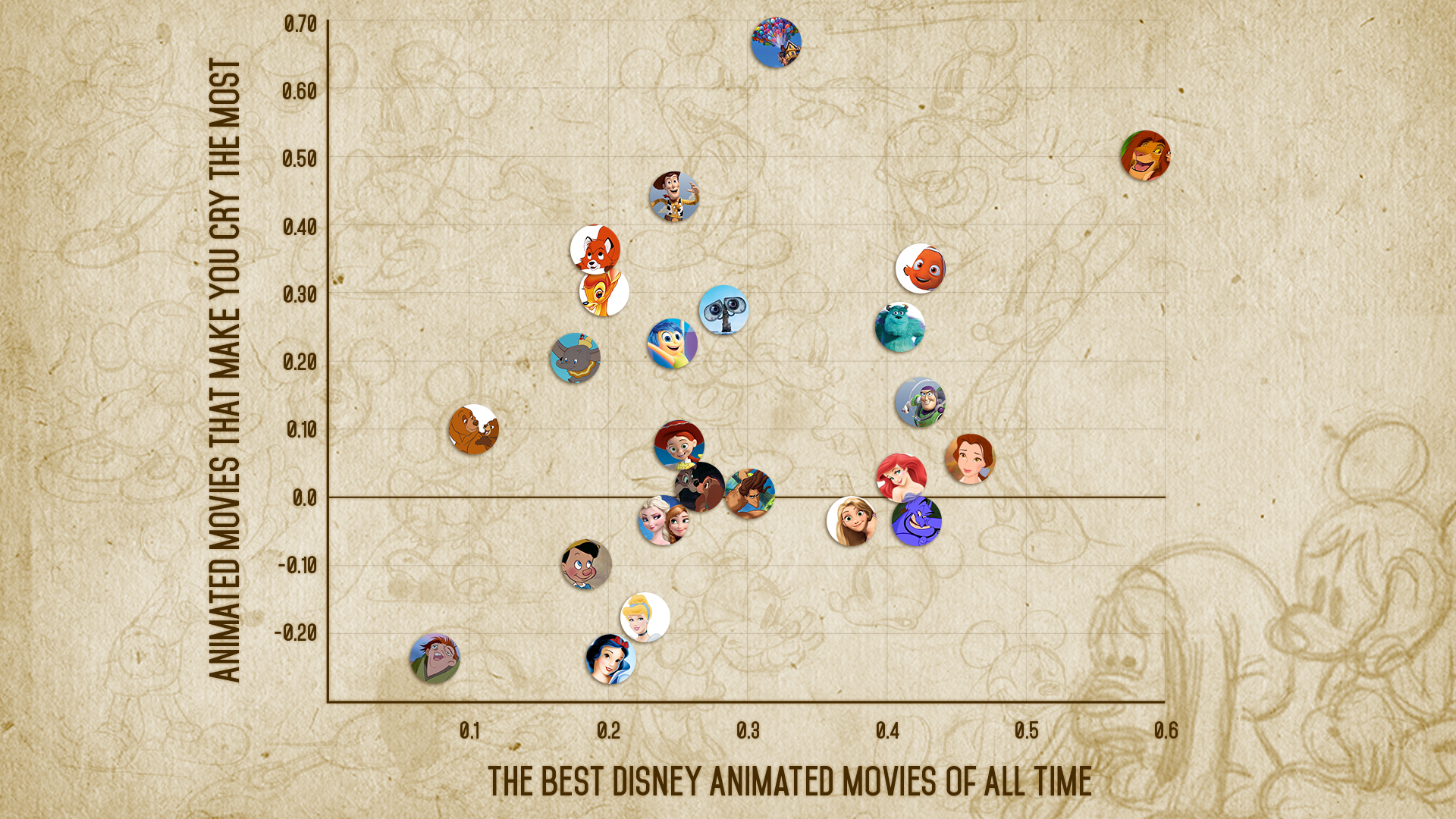The Two Most Important Elements Behind Every Beloved Disney Classic
Disney animated features are undoubtedly some of the most beloved in the world, and they’re consistently box office juggernauts. The company is known for releasing world-conquering animated films that dominate the cultural conversation, spawning mucho merchandise, memes, think pieces, theme park rides, Broadway adaptations, and least a couple of characters per season on ABC’s fantasy soap, Once Upon a Time. The Mouse doesn’t mess around.
So what’s the secret formula behind all that Disney magic? What makes the most beloved Disney animated features so beloved? Ranker Insights data has an answer, pulled not from some Mickey-shaped vault in Burbank, but from the real experts: the fans. Legions of Disney-loving Ranker users have weighed in across dozens of lists, providing us with enough data to begin reverse engineering what that magic formula is — and it all comes down to two distinct emotional factors: Sadness and Humor. If a Disney film can make you laugh and cry, then Mickey and the company have you hooked.
Disney fans know Disney animated features are tearjerkers, at least to some extent. They’re usually based on classic fairy or folk tales, full of romance, high-stakes action, and a lot of dead, absent, or solo parents. It’s no wonder we can barely keep our eyes dry. But is there a relationship between the sadness of these films and the esteem in which we hold them?
Let’s compare two relevant user-driven lists: The Best Disney Animated Movies of All Time and Animated Movies That Make You Cry the Most. The top five films on Ranker’s The Best Disney Animated Movies Of All Time list are all on the Animated Movies That Make You Cry the Most list, and the top seven films on the latter list are all Disney animated features. There’s a clear connection — Disney does sad, and Disney does sad well. But when you really dig in and start exploring the data, it becomes clear that there actually is such a thing as too sad when it comes to Disney.
Let’s first look at two of the most notoriously sad Disney features: Up and Toy Story 3. The opening montages in both films could make Maleficent blink back tears. Naturally, they both rank high on the animated tearjerkers list, at #1 and #3, respectively, and they are considered by critics to be two of the finest animated films of all time. So why don’t they land in the upper echelon of Disney animated classics?
Early-’90s-era, pre-Pixar Disney classics The Lion King, Aladdin, and Beauty and the Beast were smashes, and thus they justifiably top the Best list. They’re all musicals released within a few years of each other and are remembered fondly by Millennials. However, they aren’t necessarily all major tearjerkers — The Lion Kingbeing the obvious exception. The Lion King is the rare Disney classic that’s considered both a major tearjerker — #2 on Animated Movies That Make You Cry the Most — and in the upper echelon of Animated Disney movies. At surface value, Simba stands alone in the pack — but let’s not get ahead of ourselves.
If we factor in all tearjerkers and not just animated films, The Lion King doesn’t rank nearly as high, especially with men. Up (#4), a movie centered around a dead spouse, and Toy Story 3 (#7), which, spoiler alert, is about toys almost expiring in a furnace, make the room a whole lot dustier for men than Simba singing “Hakuna Matata” with Timon and Pumbaa (#12). That’s consistent with contemporary gender norms, as well. On the overall tearjerkers list, too, The Lion King sits at #14, well-below Toy Story 3 (#5) and just a notch below Up(#13). A sad flick? Sure. But, it’s not quite Pixar-at-its-saddest sad.
So the level of sadness a Disney animated film makes us feel has a clear correlation to our perception of its quality, but there’s a limit to the amount of melancholy we’re willing to endure. Surely, there’s another emotion that exhibits a clearer relationship…
Unsurprisingly, the Disney animated features ranked as the funniest are also the ones most often considered better. These are films, after all, featuring a menagerie of goofball fauna, wisecracking toys, genies, monsters, cars, and at least one anthropomorphized doorknob, courtesy of Alice in Wonderland. Even the bleakest, most mature of these films, such as Wall-E and Up, still have it out for your funny bone.
Interestingly, Disney’s post-1995 run of Pixar classics, including Toy Story, Finding Nemo, and Monsters, Inc., all rank high as tearjerkers, comedy classics, and some of the best Disney has to offer. It’s no surprise these films kicked off a renaissance for the studio, largely eclipsing their non-Pixar offerings until the massive success of Frozen in 2013.
Overall, the emotion these films provoke relates to whether or not they’re considered great, with the perfect combination of sadness and humor being the “secret sauce.”
One of the most exciting aspects of Ranker Insights is the ability to cross-reference this kind of data. You may have suspected, for example, that there was something inherent to movies such as Toy Story and Finding Nemo that has made them the newest of Disney’s vaunted animated classics. Knowing just why people like these movies helps us to discover what, exactly, appeals to them. Other data sources — IMDB ratings, Fresh vs. Rotten fan scores on Rotten Tomatoes, the number of Facebook likes on a fan page — can’t disentangle these emotional reactions the way Ranker can, which is a happy ending for anyone trying to decipher what makes a piece of entertainment beloved.



